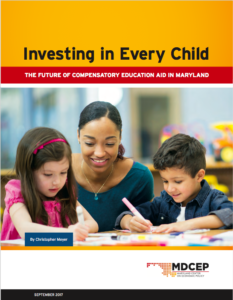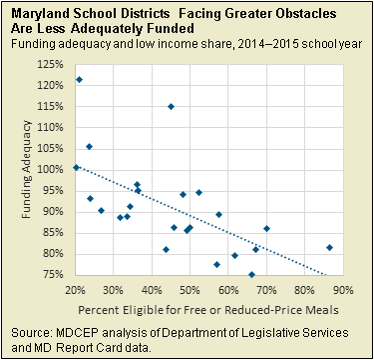Investing in Great Schools for All Students
With Effective Supports, Children Can Overcome Barriers to Academic Success
Public education is part of the foundation of a thriving state. High-quality public schools embody our commitment to ensure that all children have the opportunity to learn and succeed. Good schools also strengthen our economy by building a skilled workforce and making Maryland an attractive place to live and do business.
That’s why it is essential to guarantee that children in every part of Maryland have access to first-rate public schools. We now have a rare opportunity to turn that promise into a reality, thanks to a top-to-bottom review of our education system currently under way in Annapolis. If this process generates effective reforms, it will benefit Maryland children and our economy for many years to come.
Maryland Should Do More to Help Students Overcome Barriers
One of the most important tasks before policymakers is to design an effective system of supports for students who face obstacles to learning. When children grow up in families that struggle to afford the basics, they often face an array of challenges in daily life. They are more likely to develop health problems than children in wealthier families. They don’t always have reliable access to necessities like food, housing, and health care. Many face environmental hazards in the home and violence outside of it. These challenges can take a toll on the body and mind, producing physiological stress and interfering with brain development. As a result, children in low-income families often have a harder time in school than their wealthier peers.
Compensatory education aid is an essential policy tool that helps children overcome these barriers. It is a targeted state education grant intended to help school districts effectively serve low-income students. A large body of research shows that providing additional funding—and investing it in evidence-based practices like expanded learning time and one-on-one tutoring—can make a big difference in children’s lives. Unfortunately, Maryland’s current school funding system leaves too many students behind.
- Twenty of Maryland’s 24 school districts are now underfunded, thanks to a series of gradual cuts to state aid following the Great Recession.[i] School districts with lower property values and incomes were hit hardest, as they are the most dependent on funding from the state.
- Independent analyses by the Maryland Center on Economic Policy, the National Center on Education and the Economy, and the Education Law Center show that the Maryland school districts facing the greatest obstacles often are less well funded than other districts.[ii]
- Maryland’s compensatory education system is due for updates. The state’s method for counting low-income students is becoming less effective, and our system does too little to address the unique challenges facing communities with concentrated poverty. The current reform process represents a chance to address these issues.
Better Policy Can Make a Difference
 In a new report, “Investing in Every Child: The Future of Compensatory Education Aid in Maryland,” the Maryland Center on Economic Policy examines the state’s compensatory education system and recommends policy solutions to make it more effective. Policymakers should take three steps to ensure that all schools have the resources to set children up for success:
In a new report, “Investing in Every Child: The Future of Compensatory Education Aid in Maryland,” the Maryland Center on Economic Policy examines the state’s compensatory education system and recommends policy solutions to make it more effective. Policymakers should take three steps to ensure that all schools have the resources to set children up for success:
- Modernize the way low-income students are counted. An effective compensatory education system requires accurate data on the number of low-income students in each school district. The state historically counted students as low income if they were eligible for free or reduced-price lunch. This method is less reliable today than in the past because many schools now provide free lunch to every student. A better method is direct certification, which involves matching school records with data from other public agencies that already collect income information.
- Strengthen support for low-income districts. Maryland’s lower-income school districts are less well funded than wealthier districts, which makes it harder for them to balance their budgets, attract well-qualified teachers, and ensure that students succeed. To fix this imbalance, Maryland should strengthen compensatory education by increasing the low-income student weight used in the funding formula.
- Target resources toward concentrations of poverty. Currently, school districts get the same amount of compensatory education aid for each low-income student. However, the barriers students face magnify when large numbers of low-income students attend the same school. This makes it harder for all students in the school to succeed. Providing additional resources in communities that face concentrated poverty would enable students in these areas to access the supports they need to thrive.
Maryland schools at their best show what is possible when we make strong investments in learning. However, not all children in our state have the same access to a first-rate education. The education policy review that is now under way presents an opportunity to ensure that all children can achieve their full potential. By strengthening Maryland’s supports for students who face barriers to learning, we can build an education system to be proud of.
[i] “Adequacy of Education Funding in Maryland,” Department of Legislative Services, January 9, 2017, http://mgaleg.maryland.gov/Pubs/CommTFWorkgrp/2017-Innovation-Excellence-in-Education-Commission-2017-01-09.pdf#page=77
[ii] Christopher Meyer, “Expanding Educational Opportunity in Maryland: The Role of Funding Formulas in Increasing Equity,” Maryland Center on Economic Policy, 2017, http://www.mdeconomy.org/wp-content/uploads/2017/03/MDCEP_EdFundingMD_2017_FNL2lo.pdf
Bruce Baker, Danielle Farrie, Monete Johnson, Theresa Luhm, and David Sciarra, “Is School Funding Fair? A National Report Card: Sixth Edition,” Education Law Center, January 2017, http://www.edlawcenter.org/assets/files/pdfs/publications/National_Report_Card_2017.pdf
Marc Tucker, “Summary: Gap Analysis for Building Block 2,” National Center on Education and the Economy, July 26, 2017, http://mgaleg.maryland.gov/Pubs/CommTFWorkgrp/2017-Innovation-Excellence-in-Education-Commission-2017-07-26.pdf#page=52

